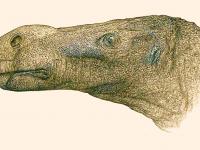Sauroniops

Sauroniops is a genus of predatory basal carcharodontosaurid theropod dinosaur known from the Late Cretaceous (Cenomanian stage) of Morocco.
Sauroniops was a very large, bipedal theropod. It likely evolved from the Jurassic, North American Allosaurus, a large and deadly predator on its own. Being one of the largest land predators yet discovered, it grew to be 40 feet (12 meters) long, 17 feet (5.2 meters) tall, and 6 tons in weight. Although little is known or has been discovered about it, we can also get a pretty good picture of what Sauroniops was like from its carcharodontosaurian cousins, like its African relatives Carcharodontosaurus, Bahariasaurus, and Deltadromeus, and its South American relatives Giganotosaurus, Mapusaurus, and Tyrannotitan.
In the early twenty-first century a collector donated a dinosaur skull bone to the Italian Museo Paleontologico di Montevarchi. He had acquired the specimen from a Moroccan fossil dealer, who again had bought the piece from local fossil hunters near Taouz. Its exact provenance is therefore uncertain. Later research showed that it presented a new species that was in 2012 reported and described by Andrea Cau, Marco Dalla Vecchia and Matteo Fabbri.
The same year, 2012, the specimen was by the same authors formally named in a subsequent publication as the type species Sauroniops pachytholus. The generic name has the intended meaning of “Eye of Sauron”, a demonic entity from the Lord of the Rings fantasy novel by J.R.R. Tolkien, combining its name with a Classical Greek ὄψ, ops, “eye”. Like in the novels the corporeal presence of Sauron had largely been limited to a single searching eye, Sauroniops is only known from a single bone above the eye socket. The specific name is derived from Greek παχύς, pachys, “thick”, and θόλος, tholos, “round building with conical roof”, in reference to the thick vaulted skull roof.
The holotype, specimen MPM 2594, had probably been recovered from the Kem Kem Beds dating from the Cenomanian. It consists of a left frontal bone.
It had a large head, possibly over 5 feet (1.5 meters) long, and like its carnosaurian cousins, had long, bladelike teeth that were perfectly designed for piercing flesh. It had two long, powerful back legs with taloned feet and somewhat short arms with three clawed hands. It also had a long, extending tail that would’ve greatly helped balance out its massive head. One feature that sets Sauroniops apart from its relatives is that it had bumps and knobs on its head that may have been used for head-butting for fighting over mates and territory. Like its other cousin, Carcharodontosaurus, it was an apex predator in Africa, and would likely have eaten anything it could catch and kill, including the hadrosaur Ouranosaurus and the sauropod Paralititan. It likely competed for territory with rivals and possibly even other large predators like Carcharodontosaurus, Deltadromeus, Bahariasaurus, Spinosaurus, and maybe even the giant crocodile Sarcosuchus.










